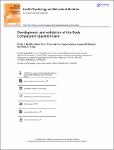Development and validation of the Body Compassion Questionnaire
| dc.contributor.author | Beadle, ES | |
| dc.contributor.author | bahrami, ali | |
| dc.contributor.author | Akhtar, S | |
| dc.contributor.author | Lennox, J | |
| dc.contributor.author | McGuire, L | |
| dc.contributor.author | Troop, Nicholas | |
| dc.date.accessioned | 2022-01-05T15:08:42Z | |
| dc.date.available | 2022-01-05T15:08:42Z | |
| dc.date.issued | 2021-01-01 | |
| dc.identifier.issn | 2164-2850 | |
| dc.identifier.issn | 2164-2850 | |
| dc.identifier.uri | http://hdl.handle.net/10026.1/18530 | |
| dc.description | File replaced (docx to pdf) on 27.4.23 by NK (LDS) | |
| dc.description.abstract |
BACKGROUND: The associations between compassion, self-compassion, and body image are well established. However, there is not yet a compassion-informed measure of body compassion that can be applied to any aspect of one's body. METHOD: Items for The Body Compassion Questionnaire (BCQ) were derived from an earlier expressive writing study on self-compassion in body image. In study 1, the BCQ was completed by 728 men and women; with factor analysis, Rasch analysis, content and concurrent validation and reliability assessed. Study 2 compared BCQ scores with investigator-based ratings of spontaneous expressions of body compassion through writing in female undergraduates as well as an existing measure of body compassion. Study 3 examined the associations between BCQ scores, and the emotions expressed in a structured body image writing task. It also examined the relative predictive ability of the BCQ versus self-compassion in predicting eating pathology. RESULTS: A bi-factor structure was identified, with an overall BCQ score and three subscales: body kindness, common humanity, and motivated action. The BCQ and its subscales had good validity and reliability and Rasch analysis showed the item fit was invariant across a range of demographic characteristics. Spontaneous expressions of body compassion showed positive associations with body kindness. Overall BCQ scores and body kindness were also inversely related to negative emotions expressed in relation to body image. The BCQ was a better predictor of eating disorder symptoms than was self-compassion. CONCLUSIONS: The BCQ is the first measure of body compassion that is aligned with theoretical aspects of self-compassion, and which includes aspects of both the first and second psychologies of compassion. It also highlights its potential use as a process measure of body compassion in models of eating disorder symptomology, mood and wellbeing as well as an outcome measure for compassion-based interventions in eating disorders and body image. | |
| dc.format.extent | 951-988 | |
| dc.format.medium | Electronic-eCollection | |
| dc.language | en | |
| dc.language.iso | eng | |
| dc.publisher | Informa UK Limited | |
| dc.subject | Body compassion | |
| dc.subject | body image | |
| dc.subject | eating behaviour | |
| dc.subject | self-compassion | |
| dc.title | Development and validation of the Body Compassion Questionnaire | |
| dc.type | journal-article | |
| dc.type | Journal Article | |
| plymouth.author-url | https://www.ncbi.nlm.nih.gov/pubmed/34868737 | |
| plymouth.issue | 1 | |
| plymouth.volume | 9 | |
| plymouth.publication-status | Published | |
| plymouth.journal | Health Psychology and Behavioral Medicine | |
| dc.identifier.doi | 10.1080/21642850.2021.1993229 | |
| plymouth.organisational-group | /Plymouth | |
| plymouth.organisational-group | /Plymouth/Faculty of Health | |
| plymouth.organisational-group | /Plymouth/Faculty of Health/School of Psychology | |
| plymouth.organisational-group | /Plymouth/Users by role | |
| plymouth.organisational-group | /Plymouth/Users by role/Academics | |
| dc.publisher.place | England | |
| dc.identifier.eissn | 2164-2850 | |
| dc.rights.embargoperiod | Not known | |
| rioxxterms.versionofrecord | 10.1080/21642850.2021.1993229 | |
| rioxxterms.licenseref.uri | http://www.rioxx.net/licenses/all-rights-reserved | |
| rioxxterms.type | Journal Article/Review |


